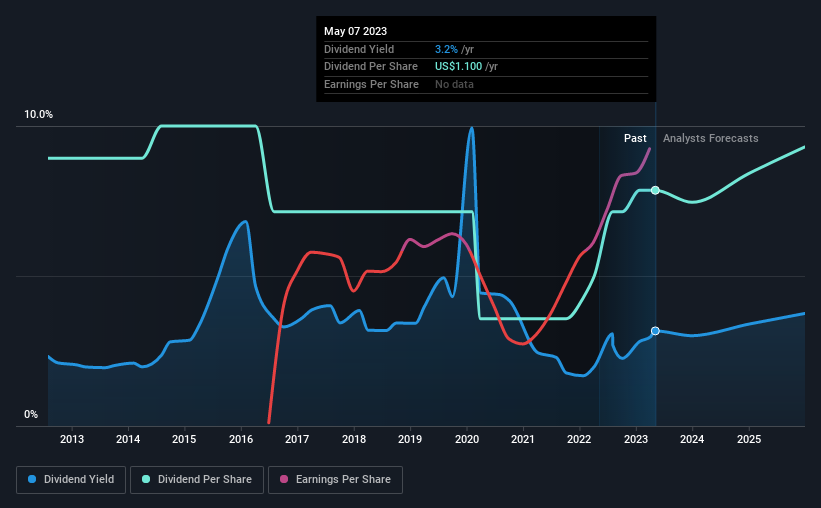Be Sure To Check Out Murphy Oil Corporation (NYSE:MUR) Before It Goes Ex-Dividend
Readers hoping to buy Murphy Oil Corporation (NYSE:MUR) for its dividend will need to make their move shortly, as the stock is about to trade ex-dividend. The ex-dividend date occurs one day before the record date which is the day on which shareholders need to be on the company's books in order to receive a dividend. The ex-dividend date is an important date to be aware of as any purchase of the stock made on or after this date might mean a late settlement that doesn't show on the record date. Therefore, if you purchase Murphy Oil's shares on or after the 12th of May, you won't be eligible to receive the dividend, when it is paid on the 1st of June.
The company's next dividend payment will be US$0.28 per share, on the back of last year when the company paid a total of US$1.10 to shareholders. Last year's total dividend payments show that Murphy Oil has a trailing yield of 3.2% on the current share price of $34.7. Dividends are an important source of income to many shareholders, but the health of the business is crucial to maintaining those dividends. We need to see whether the dividend is covered by earnings and if it's growing.
Check out our latest analysis for Murphy Oil
Dividends are typically paid out of company income, so if a company pays out more than it earned, its dividend is usually at a higher risk of being cut. Murphy Oil is paying out just 12% of its profit after tax, which is comfortably low and leaves plenty of breathing room in the case of adverse events. A useful secondary check can be to evaluate whether Murphy Oil generated enough free cash flow to afford its dividend. What's good is that dividends were well covered by free cash flow, with the company paying out 17% of its cash flow last year.
It's positive to see that Murphy Oil's dividend is covered by both profits and cash flow, since this is generally a sign that the dividend is sustainable, and a lower payout ratio usually suggests a greater margin of safety before the dividend gets cut.
Click here to see the company's payout ratio, plus analyst estimates of its future dividends.
Have Earnings And Dividends Been Growing?
Businesses with strong growth prospects usually make the best dividend payers, because it's easier to grow dividends when earnings per share are improving. If earnings decline and the company is forced to cut its dividend, investors could watch the value of their investment go up in smoke. It's encouraging to see Murphy Oil has grown its earnings rapidly, up 31% a year for the past five years. Murphy Oil earnings per share have been sprinting ahead like the Road Runner at a track and field day; scarcely stopping even for a cheeky "beep-beep". We also like that it is reinvesting most of its profits in its business.'
Another key way to measure a company's dividend prospects is by measuring its historical rate of dividend growth. Murphy Oil's dividend payments per share have declined at 1.3% per year on average over the past 10 years, which is uninspiring.
The Bottom Line
Is Murphy Oil an attractive dividend stock, or better left on the shelf? It's great that Murphy Oil is growing earnings per share while simultaneously paying out a low percentage of both its earnings and cash flow. It's disappointing to see the dividend has been cut at least once in the past, but as things stand now, the low payout ratio suggests a conservative approach to dividends, which we like. There's a lot to like about Murphy Oil, and we would prioritise taking a closer look at it.
While it's tempting to invest in Murphy Oil for the dividends alone, you should always be mindful of the risks involved. For instance, we've identified 3 warning signs for Murphy Oil (1 shouldn't be ignored) you should be aware of.
Generally, we wouldn't recommend just buying the first dividend stock you see. Here's a curated list of interesting stocks that are strong dividend payers.
Have feedback on this article? Concerned about the content? Get in touch with us directly. Alternatively, email editorial-team (at) simplywallst.com.
This article by Simply Wall St is general in nature. We provide commentary based on historical data and analyst forecasts only using an unbiased methodology and our articles are not intended to be financial advice. It does not constitute a recommendation to buy or sell any stock, and does not take account of your objectives, or your financial situation. We aim to bring you long-term focused analysis driven by fundamental data. Note that our analysis may not factor in the latest price-sensitive company announcements or qualitative material. Simply Wall St has no position in any stocks mentioned.
Join A Paid User Research Session
You’ll receive a US$30 Amazon Gift card for 1 hour of your time while helping us build better investing tools for the individual investors like yourself. Sign up here

 Yahoo Finance
Yahoo Finance 
